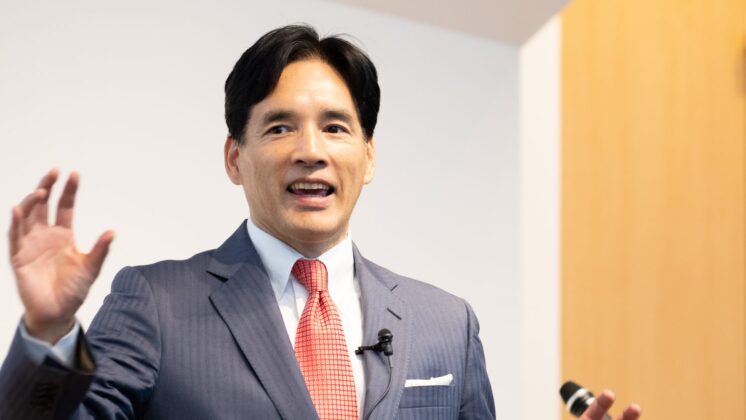I arrived at my hotel in New York a little after 10 p.m. on Saturday. The hotel upgraded my room to a single overlooking Central Park because I’d stayed there many times before. I went to bed early that night because my business in Los Angeles, snowboarding in Vail, and the GLS had worn me out.
The next morning, sitting at the desk in my room, I took care of a huge pile of pending jobs. The green of Central Park spread out in front of me. The sky above was turquoise. After that morning task was done, for the first time in many days I spent the entire day relaxing. When I’ve made up my mind to goof off, I do absolutely nothing and just idle the day away. I can’t refresh myself with lukewarm laziness. I have to act completely lazy in order to be refreshed. That lets me refresh my head and recharge my batteries for the next job. That night I met an old friend and had an enjoyable conversation over dinner.
My work in New York began the next day. I was scheduled to visit investors who for more than 10 years had supported a GLOBIS venture capital firm called GLOBIS Capital Partners (GCP), together with GCP’s Soichi Kariyazono, to explain the current state of GCP funding. My plan was to devote my two days in New York to these visits and dinners with my close friends.
It isn’t widely known, but overseas investors supply more than 80% of the capital that GCP needs for establishing its 40-billion yen class funds. They supply such a high ratio of capital because GCP had trouble raising funds in Japan and needed to depend on overseas investment. Overseas investors are the ones who have supported GCP’s activities for incubating venture businesses in Japan. The operations of GCP-assisted venture companies like GREE, Inc. and Works Applications owe a great deal to foreign investment.
I’d like to ask institutional investors in Japan to put their money into venture capital instead of buying government bonds. New values and dynamism do not arise in a society unless money goes to venture capital, and a shortage of funds is the biggest cause of slow and insufficient venture capital growth in Japan.
The first GCP fund was a little over 500 million yen in size, but the capital for the second one grew to 20 billion yen, thanks to the more than 18 billion yen the company raised overseas. I think that that GCP would have raised less than 2 billion yen if it insisted on finding investors in Japan. Venture capital that cannot raise funds from overseas investors will stay small, and can’t incubate capitalists.
Overseas investors base their investment decisions on individuals, rather than companies. Institutional investors overseas chose to inject hundreds of millions of yen into GCP based on their respective judgment that I, this 37-year old entrepreneur, could be trusted. I visit these investors periodically to report to them in person. They tell me how happy they are when I report to them on good returns that meet their expectations. So, I was going to meet investors in and around New York that day and the next.
Pension funds and university endowments account for a large portion of funds that go to venture capital in the United States. In the meantime, both pension funds and university endowments make frequent use of government bonds for managing their funds in Japan. One university endowment in Japan received this notice from the Ministry of Education, Culture, Sports, Science and Technology after reporting a loss on derivatives trading: “Do everything possible to manage funds in a capital-safe way.”
I found this incident despicable. As a matter of course, we plan to allocate at least half the endowment for the Graduate School of Management, GLOBIS University to venture capital investment.
Investors I visited that day showed me the following two articles. Arguments for reexamining Japan have flourished in North America and Europe in recent years. I think Japanese companies’ share prices will rise from this point on.
Stop looking in the rear-view mirror at Japan (http://goo.gl/iLHOD)
A compelling case for investing in Japan (http://goo.gl/hSV0o)
On my second day in New York, I chartered a private jet to visit an investor in Michigan. I left my hotel at 6:15 a.m. for a small airport located in New Jersey. I boarded the private jet there a little after 7. There were no security checks or check-in procedures for this private flight. On the way to the airport, I noticed I’d left my passport in my hotel room and went back just to pick it up. But it turned out I didn’t need it for this trip. The private jet took off from the airport at 7:10.
The plane veered its nose right and flew straight to Michigan. I could see the skyscrapers of Manhattan in the distance. There were only two passengers in this seven-seater. This was my second time to travel in a private jet. (See my previous column, “Three Week, Round-the-World Business Trip (Part 8: Michigan)” available in Japanese only at http://goo.gl/3Vj2d for my first private jet experience.)
The flat landscape continued. I felt sleepy and dozed off; when I awoke, I could see a white plain spread down below. I could see one of the Great Lakes, Lake Ontario, frozen over white below and to the right. The jet veered down and landed as if it were being sucked into the white expanse. I walked down the runway from the plane, passed through a hangar, and rode a black cab awaiting me outside the airport.
Since I had arrived in Michigan ahead of schedule, I went and enjoyed a double-decker cheese burger at a Big Boy family restaurant filled with Midwestern customers, with their country-like demeanor. I felt like I’d been transported to a Hollywood movie. I visited a GCP investor at his office a little before 10 a.m., and after discussing GCP operations intensively for an hour and a half, got back in the black cab.
The taxi traveled the same roads back to the airport. I felt great because the meeting had gone well. I boarded the jet soon after reaching the airport. The engine started and the plane left the ground. The jet flew into the blue sky over the white plain that continued on endlessly. I hadn’t realized the Midwest was so flat. Nothing blocked the view of the horizon. I took out some snacks, munched on them and had my second nap.
I awoke to the Statue of Liberty and the Manhattan skyscrapers coming into view. There was a sense of melancholy in the Manhattan view because the World Trade Center twin towers were no longer part of it. After landing, I said goodbye to my pilot, took a minibus to leave the runway, walked out of the airport, and took a limousine awaiting me. Absolutely no time was wasted in changing modes of transportation. The transfer was entirely stress-free.
I returned to my New York hotel and then at 3 p.m. I visited the office of Apax Partners, which had been a joint venture partner for GLOBIS, had a pleasant chat with old friends there, and went back to the hotel. That night I had a delightful reunion with Professor Gerald Curtis of Columbia University.
On the last day of my 11-day trip, I enjoyed a power breakfast at 7:30 and left my hotel for John F. Kennedy International Airport at 8:30. I called my house on the way to the airport, and my kids gave me a happy report. “Our soccer coach gave me a gold medal because I lifted the ball 145 times,” my third son in the third grade told me. “I moved up to the 31st rank at go,” reported my fifth son, age five. I thought about how I’d be able to see them again soon.
I made these four tweets while waiting for my flight in a lounge at JFK.
I’m in a lounge at JFK Airport, flying back to Tokyo from here. About to complete my 11-day trip that began in Los Angeles. I snowboarded in Vail, attended an entrepreneurs’ meeting in Denver and visited investors in New York. This hugely productive trip taught me the real strength and diversity of the United States.
Professor Gerald Curtis asked me this question last night. “Do you have a positive view about Japan’s future?” I gave a clear-cut response. “It’s not a matter of having a positive view. I’ve decided to make Japan better with the fellow members of my generation. There was no earlier period in the history of Japan that was as exciting as this. I’m lucky to be here now.”
It’s now time for me to focus on Japan. I have no overseas business trip scheduled until the end of April. I’m going to settle myself down, make a broad range of proposals and take different actions. Japanese politics are undergoing a process of “creative destruction,” too. Something like a new phoenix will rise from this chaos. I can’t afford to miss this opportunity to take an active part in this ongoing reform.
I feel that the contemporary versions of key figures behind the Meiji Restoration, such as Ryoma Sakamoto, Toko Fujita, Takamori Saigo and Kogoro Katsura, will appear in this age. A bird flaps away when it breaks out of its shell, but ends up fried over easy when someone breaks its shell from the outside. It’s time for Japan to show its real power. Come to think of it, I was born to live in this extremely exciting era. My flight was called while I was making this tweet. I’ll keep tweeting my other thoughts from Japan.
March 3, 2011
Yoshito Hori
Completed with additions and revisions on my way back from Narita Airport



